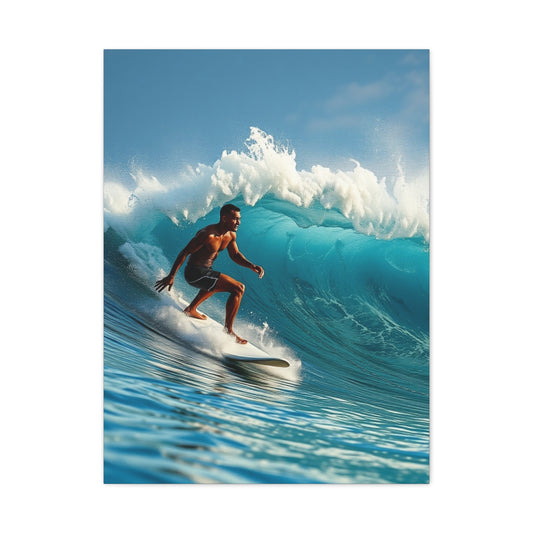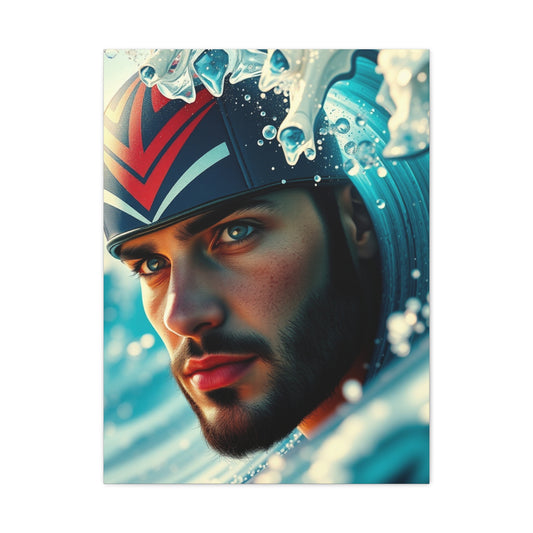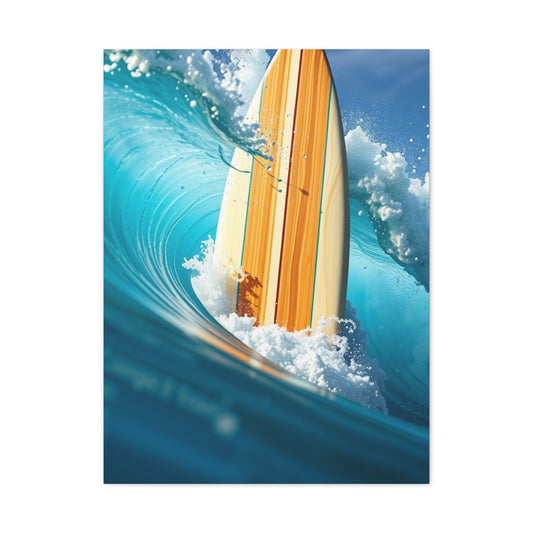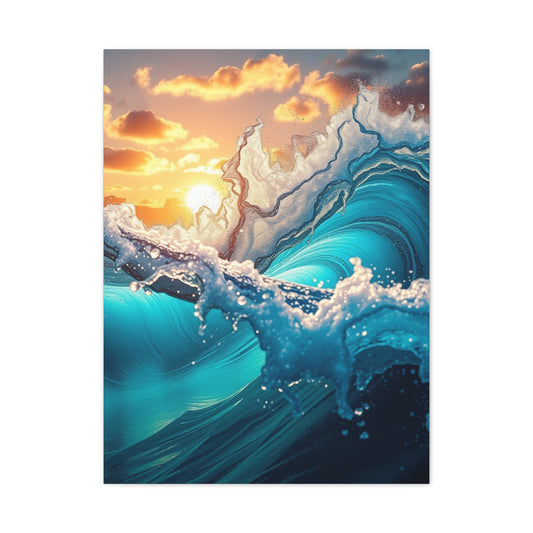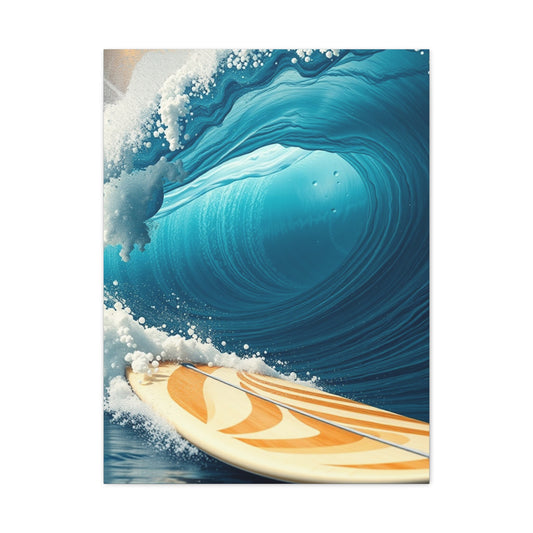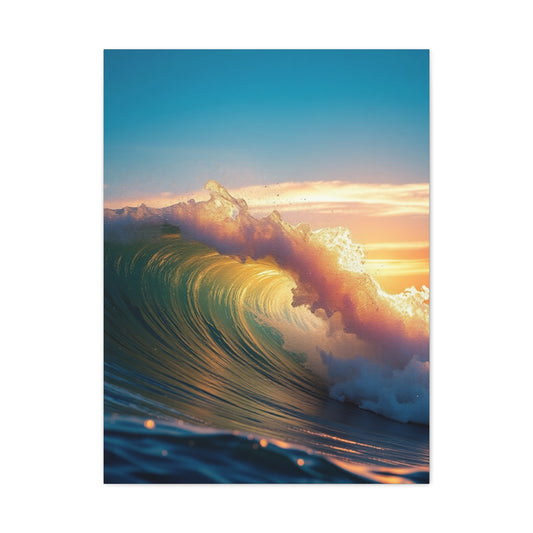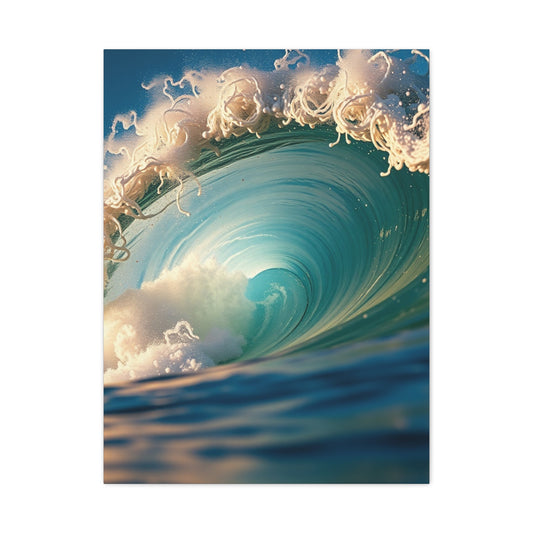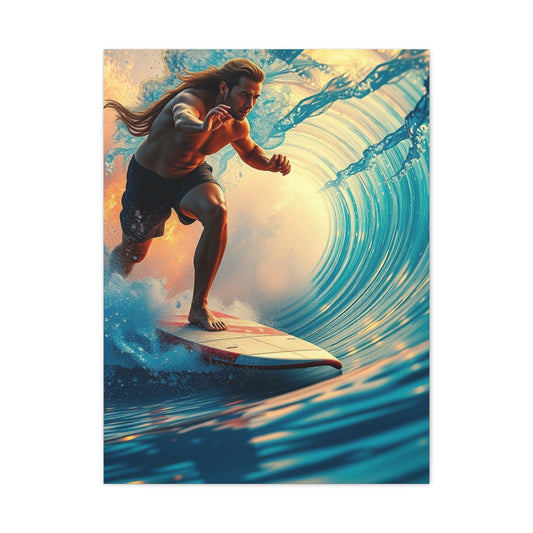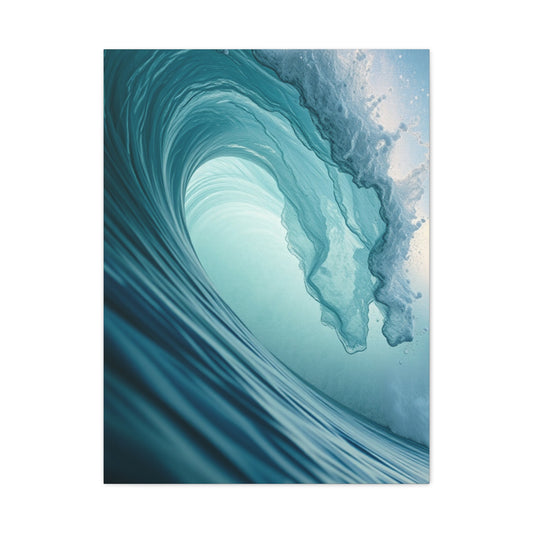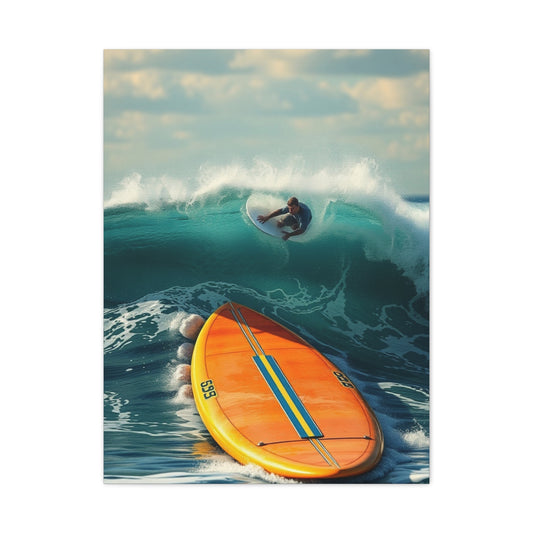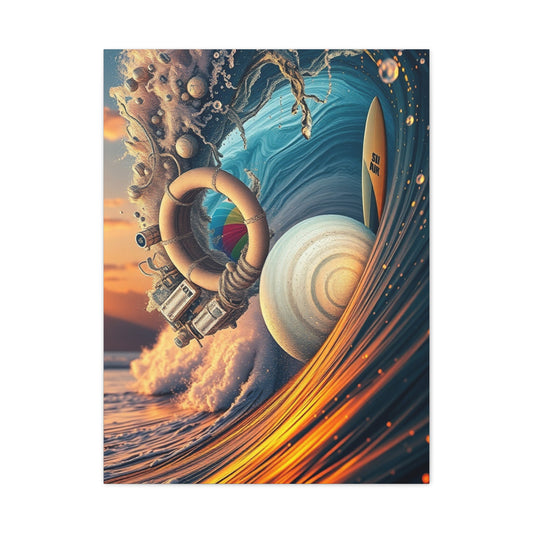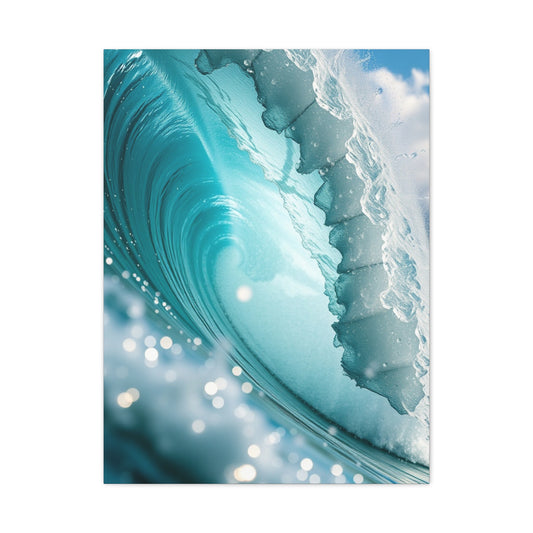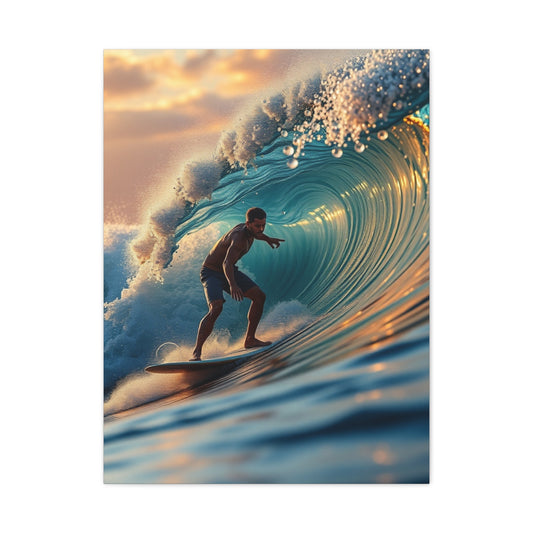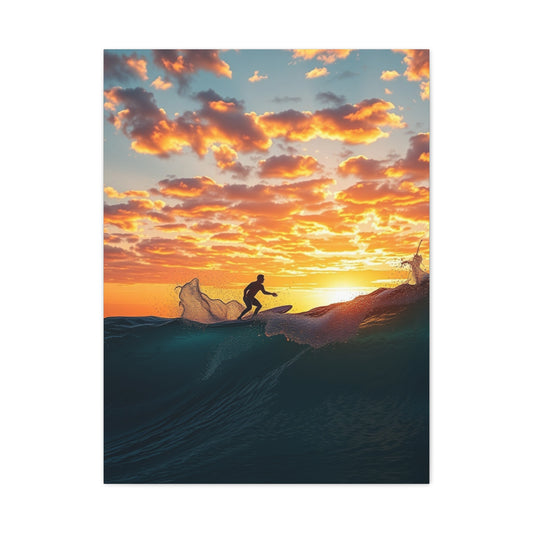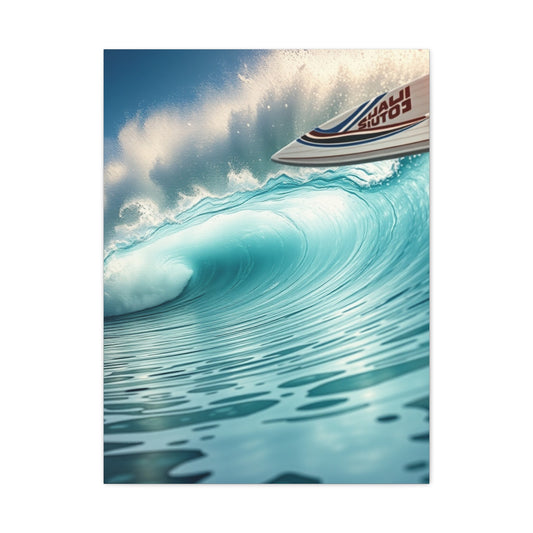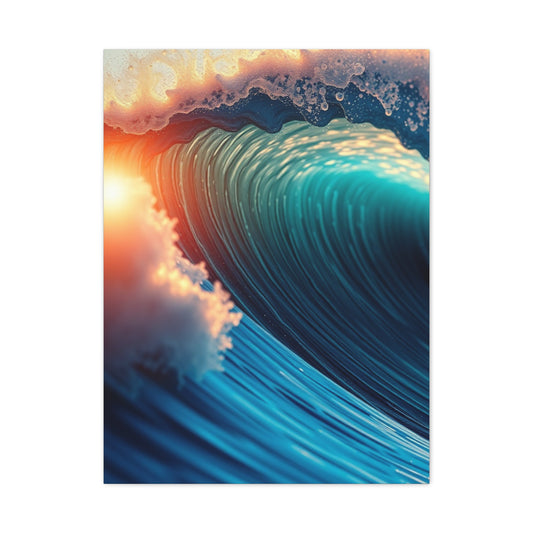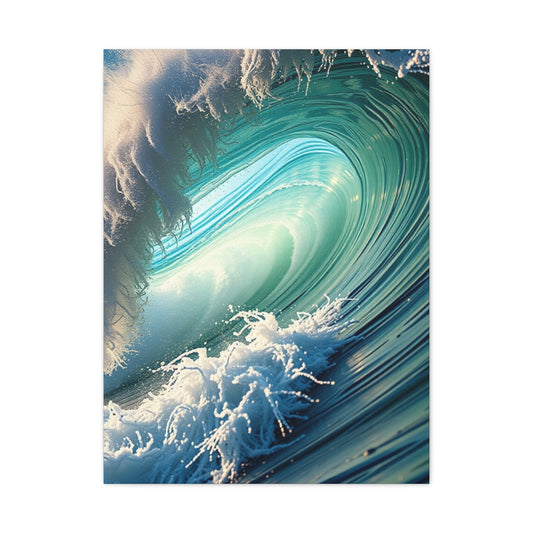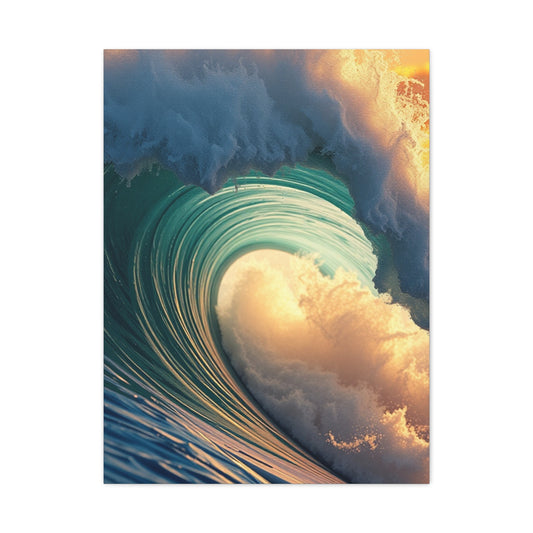Flow and Foam: The World of Surf Wall Art
Surf art is a unique artistic expression that captures the dynamic and adventurous spirit of surfing. It embodies not only the thrill of riding waves but also the culture, lifestyle, and connection to the ocean that surfers experience. Unlike other art forms, surf art reflects movement, energy, and a vivid use of color, often drawing from the natural beauty of the ocean, beaches, and coastal landscapes. It serves as a bridge between nature and human creativity, inspiring both surfers and art enthusiasts alike. This genre is not limited to any single medium; it includes paintings, illustrations, photography, sculpture, and even digital creations that celebrate the surf lifestyle.
Surf art provides a visual narrative of the surfing experience, capturing moments that might otherwise be fleeting. It communicates emotions ranging from exhilaration during a perfect wave to the tranquility of watching the ocean at sunrise. Artists in this field often immerse themselves in the surf culture, gaining a deeper understanding of the nuances, rituals, and lifestyles that define it. The result is artwork that resonates with both surfers and those who appreciate the ocean’s beauty, whether they participate in the sport themselves or simply admire it from afar.
Origins and Evolution of Surf Art
The origins of surf art can be traced back to coastal communities where surfing first gained popularity. In places like Hawaii, Australia, and California, early depictions of surf culture appeared in various forms, including photography, sketches, and handmade surfboard designs. These early representations were not just artistic expressions but also cultural documentation, preserving the heritage and lifestyle of surfing communities. Over time, surf art evolved to encompass a wide range of styles and techniques, reflecting changes in the sport, technological advancements, and broader artistic trends.
During the mid-twentieth century, surf art began to gain recognition beyond local communities. Artists started experimenting with bold colors, abstract forms, and dynamic compositions to capture the essence of surfing. The 1960s surf culture boom, particularly in California and Hawaii, brought the sport into popular consciousness and inspired artists to create works that celebrated the freedom, adventure, and beauty associated with surfing. Photographers captured action shots of surfers conquering massive waves, while painters and illustrators translated the fluidity and energy of surfing onto canvas and board.
As surf culture spread globally, surf art began to adapt to different artistic influences. Contemporary artists combine traditional techniques with modern approaches, incorporating digital tools, mixed media, and large-scale installations. Today, surf art continues to evolve, reflecting the diversity of the surfing community and the ongoing dialogue between art, nature, and human experience. Its evolution demonstrates how an art form rooted in a specific lifestyle can grow into a dynamic, multifaceted genre that resonates across cultures.
Key Themes in Surf Art
Surf art often revolves around themes that reflect the essence of surfing and the ocean. One of the primary themes is the interplay between humans and nature. Surfing is a sport that requires an intimate understanding of the ocean, its waves, tides, and rhythms. Artists translate this relationship into visual narratives, emphasizing motion, energy, and the power of the sea. The depiction of waves, water currents, and the surfers’ interaction with them captures the fluidity and unpredictability of the ocean, inviting viewers to experience the thrill and beauty of surfing.
Another recurring theme in surf art is community and lifestyle. Surfing is not only a personal endeavor but also a social activity. Surfing communities often share rituals, values, and environmental consciousness that become integral parts of the art. Many works depict group surfing experiences, beach gatherings, or scenes of surfers preparing for the waves. This portrayal reinforces the idea that surf art is not just about the act of surfing but also about the lifestyle, camaraderie, and culture surrounding it.
Environmental awareness is also a prominent theme in surf art. Artists use their work to highlight the importance of preserving oceans, beaches, and marine ecosystems. Surf art often conveys messages about climate change, pollution, and the need for sustainable practices. By blending aesthetic beauty with ecological consciousness, surf artists inspire viewers to appreciate and protect the natural world. This thematic focus bridges the gap between art, activism, and lifestyle, making surf art a meaningful and socially relevant genre.
Media and Techniques in Surf Art
Surf art can be expressed through a variety of media, each offering distinct possibilities for capturing the essence of surfing. Painting is one of the most traditional forms, with artists using watercolors, acrylics, oils, and mixed media to portray waves, surfers, and coastal landscapes. Painters often experiment with abstraction and realism, translating the motion and energy of the ocean into vivid compositions that evoke both excitement and tranquility.
Illustration and graphic design are also central to surf art. Illustrators create detailed depictions of surfing scenes, surfboards, and oceanic motifs using hand-drawn techniques or digital tools. This medium allows for playful creativity, incorporating elements of pop culture, surf music, and iconic imagery. Illustrations often appear on merchandise such as T-shirts, stickers, album covers, and surfboards, blending artistic expression with functional design.
Photography captures surf art in a unique way, freezing moments of action and beauty that are often fleeting. Surf photographers document surfers riding waves, coastal sunsets, and ocean landscapes, emphasizing lighting, composition, and timing. Through photography, the energy of surfing is preserved and shared with a wide audience. Many surf photographers have become influential artists in their own right, showcasing their work in galleries, magazines, and digital platforms worldwide.
Sculpture and three-dimensional art provide another avenue for surf expression. Artists create surfboard sculptures, wave-inspired installations, and mixed-media pieces that engage viewers in tactile and spatial experiences. These works often explore the physicality of surfing and the relationship between humans and the ocean in a tangible, immersive way.
Notable Surf Artists and Influences
Several artists have played a pivotal role in shaping the surf art movement. Thomas Campbell, for example, is renowned for his paintings, films, and surfboard designs that capture the vibrancy and spirit of surf culture. His work emphasizes bold color palettes, fluid motion, and a deep connection to the ocean. Drew Brophy is another influential figure, known for his dynamic surfboard art and public installations that bring surf culture into galleries and urban spaces. Both artists exemplify how surf art can transcend traditional boundaries, blending lifestyle, creativity, and environmental awareness.
The influence of regional cultures on surf art is also significant. Hawaiian artists often incorporate traditional symbols, mythology, and nature-inspired motifs into their work, reflecting the deep cultural heritage of surfing in the islands. Australian surf artists may draw from coastal landscapes, indigenous traditions, and contemporary urban influences, creating diverse interpretations of surfing life. California-based artists often merge surf culture with pop art, street art, and modern design trends, highlighting the adaptability and evolution of surf art across different environments.
Surf art is not only about the individuals who create it but also about the communities that inspire it. Surf festivals, galleries, and local art collectives provide platforms for artists to share their work, exchange ideas, and engage with audiences. These spaces foster innovation, collaboration, and the ongoing growth of surf art as both an artistic and cultural phenomenon.
The Emotional Impact of Surf Art
Surf art resonates emotionally because it captures experiences that many people find aspirational, inspiring, or meditative. The depiction of a perfectly formed wave, a surfer in motion, or a tranquil beach scene can evoke feelings of freedom, exhilaration, and connection to nature. The colors, composition, and energy of surf art communicate moods ranging from peaceful contemplation to intense excitement. For surfers, the art may serve as a reflection of personal experiences, while for non-surfers, it provides a window into an exciting and visually captivating world.
Many viewers are drawn to the optimism, vibrancy, and vitality embedded in surf art. The bold use of color, fluid shapes, and dynamic compositions often conveys a sense of movement and life that goes beyond static representation. This emotional engagement makes surf art accessible and appealing to a wide audience, bridging cultural and geographical boundaries. The art becomes more than a visual object; it becomes a medium for shared experience and connection to the natural world.
Illustration and Graphic Design in Surf Art
Illustration and graphic design have played a central role in surf art, providing a versatile platform for artists to capture the energy, vibrancy, and culture of surfing. Illustrators often work with both traditional media, such as pen, ink, and paint, and modern digital tools to create striking visuals that resonate with the surf community. These works frequently portray surfers riding massive waves, playful ocean creatures, or scenes of daily life at the beach. The emphasis on color, motion, and detail allows illustrations to translate the thrill of surfing into a visual narrative.
Surf illustrations often extend beyond conventional art galleries, appearing on surfboards, apparel, album covers, posters, and merchandise. This integration of art into everyday objects reflects the holistic nature of surf culture, where creativity is expressed in multiple facets of life. Many artists use whimsical, exaggerated forms and bold color schemes to convey the joy, freedom, and intensity of surfing. By bridging visual storytelling with functional design, illustration, and graphic art have become essential media for surf culture, helping to communicate its essence to both insiders and newcomers alike.
Photography as a Medium in Surf Art
Photography holds a unique place in surf art, offering a powerful means to document the fleeting and dynamic moments that define surfing. Capturing a surfer in the perfect barrel, the sunlight glinting off the crest of a wave, or the serene atmosphere of an early morning surf requires technical skill, patience, and a deep understanding of the ocean. Surf photographers are not merely observers; they are participants in the lifestyle, often spending hours in the water to achieve the ideal shot.
Beyond action photography, surf photographers also explore environmental and lifestyle themes. Images of coastal landscapes, deserted beaches, or community surf gatherings emphasize the broader context of surfing culture. Photography allows artists to express both the exhilaration and tranquility of the ocean, creating visual stories that resonate with viewers on an emotional level. The immediacy and realism of photography distinguish it from other art forms, offering a direct connection to the ocean’s raw beauty and the surfer’s experience.
Painting and Fine Art in Surf Culture
Painting has long been a cornerstone of surf art, providing a medium through which artists can interpret the ocean and surfing in diverse and imaginative ways. Many contemporary painters experiment with techniques ranging from watercolors to acrylics, capturing everything from the subtle interplay of light on water to the dramatic intensity of a breaking wave. Paintings often feature abstracted or stylized representations of the ocean, allowing viewers to feel the movement, rhythm, and energy of the surf even without direct participation.
The thematic diversity in surf painting is vast. Some artists focus on the human experience, portraying surfers navigating the challenges and beauty of waves. Others emphasize the natural world, depicting seascapes, marine life, or the changing tides and weather conditions. Paintings may convey realism, abstraction, or a blend of both, demonstrating the flexibility of the medium in expressing the multifaceted nature of surf culture. The tactile and textural qualities of paint further enhance the visual impact, allowing artists to experiment with color layering, brushstrokes, and surface effects to evoke motion and emotion.
Sculptural and Three-Dimensional Surf Art
Sculpture and three-dimensional art forms offer a unique perspective on surf culture, translating the energy and motion of the ocean into physical, tactile experiences. Artists may craft surfboard sculptures, wave-inspired installations, or mixed-media pieces that engage viewers spatially and sensorially. These works emphasize the physicality of surfing, the fluidity of water, and the dynamic interplay between humans and the ocean.
Three-dimensional surf art often incorporates unconventional materials, such as reclaimed wood, metal, and found objects, reflecting a deep connection to the natural environment. By blending sculptural technique with environmental awareness, these works highlight both artistic creativity and ecological consciousness. Large-scale installations may recreate wave formations or coastal landscapes, immersing viewers in the sensation of being at the beach or riding a wave. Sculptural surf art serves as a bridge between art, architecture, and environmental design, demonstrating the versatility and cultural relevance of this medium.
Cultural Significance of Surf Art
Surf art is more than a visual representation of surfing; it is a reflection of the broader culture, lifestyle, and values associated with the sport. Surfing has historically been tied to community, ritual, and environmental stewardship, and surf art embodies these elements through creative expression. Artistic depictions of surfers, coastal gatherings, and beach landscapes often emphasize social connections, shared experiences, and the collective identity of the surf community.
The cultural impact of surf art extends to social awareness and activism. Many artists use their work to highlight environmental concerns, such as ocean pollution, climate change, and coastal erosion. By combining aesthetic beauty with messages of conservation, surf art becomes a tool for education and advocacy, encouraging viewers to engage with pressing ecological issues. Cultural inclusivity is also evident in surf art, as artists from diverse backgrounds share unique perspectives, integrating local traditions, indigenous symbolism, and regional surf history into their work.
Modern Adaptations of Surf Art
In recent years, surf art has adapted to contemporary artistic trends and technological advancements, expanding its reach and relevance. Digital media has transformed how surf art is created, shared, and consumed. Artists now utilize digital painting, animation, virtual reality, and interactive platforms to explore new dimensions of the surf experience. Social media and online galleries have made it possible for artists to reach global audiences, fostering cross-cultural exchanges and collaborations.
Fashion is one of the most visible arenas where surf art has influenced modern design. Surf-inspired clothing and accessories often feature bold graphics, colorful patterns, and illustrations that reflect oceanic themes. Apparel, footwear, and swimwear are infused with surf aesthetics, allowing individuals to express their connection to the surf culture through personal style. Similarly, interior design incorporates surf art in the form of prints, murals, and surfboard decor, transforming homes and public spaces into immersive environments that celebrate the ocean.
Environmental and Social Messages in Surf Art
Many contemporary surf artists embed social and environmental messages in their work, highlighting the interconnection between humans and the natural world. Artworks may address ocean conservation, marine biodiversity, and climate change, inspiring viewers to reflect on their role in protecting coastal ecosystems. By linking artistic expression with environmental advocacy, surf art promotes sustainable practices and fosters a deeper appreciation for the ocean’s fragility and beauty.
Surf art also conveys social and cultural narratives, celebrating diversity within the surfing community. Artists may depict surfers of different genders, ethnicities, and ages, emphasizing inclusivity and the shared joy of engaging with the ocean. By representing multiple perspectives, surf art challenges stereotypes and broadens the understanding of what surfing culture entails. This approach reinforces the idea that surf art is not only about aesthetics but also about community, identity, and social consciousness.
The Impact of Surf Festivals and Exhibitions
Surf festivals and art exhibitions play a crucial role in shaping the surf art landscape. These events provide a platform for artists to showcase their work, connect with audiences, and exchange ideas. Festivals often combine live art demonstrations, photography exhibitions, surf competitions, and cultural performances, creating immersive experiences that celebrate the surf lifestyle. For both emerging and established artists, these gatherings offer visibility, networking opportunities, and inspiration.
Exhibitions dedicated to surf art highlight the historical and contemporary significance of the genre, documenting its evolution and impact. Curators often present works that explore themes of motion, culture, and environmental awareness, contextualizing surf art within broader artistic and societal narratives. These events attract a wide range of audiences, from surfers and collectors to art enthusiasts and environmental advocates, expanding appreciation and understanding of the genre.
Collecting and Appreciating Surf Art
Collecting surf art is a way to engage with the culture and support artists while bringing the vibrancy of the ocean into personal spaces. Collectors may focus on specific media, such as paintings, photography, or sculptures, or seek works that reflect particular themes or regional styles. Building a collection involves exploring local galleries, attending surf festivals, and discovering emerging artists who contribute fresh perspectives to the genre.
Art enthusiasts may also explore online platforms to access a global array of surf art. Digital marketplaces and artist websites provide opportunities to purchase original works, limited editions, or prints, allowing collectors to diversify their collections. Appreciating surf art involves not only admiring visual aesthetics but also understanding the narratives, cultural context, and environmental messages embedded in each piece. This approach fosters a deeper connection to both the art and the ocean it celebrates.
Global Influence of Surf Art
Surf art has transcended its regional roots to gain recognition and influence around the world. While it originated in coastal communities where surfing was prevalent, its appeal has become global due to the universality of the ocean and the lifestyle it represents. Artists from various countries draw inspiration from their own coastal environments, integrating local culture, history, and aesthetics into their work. This globalization of surf art has led to diverse interpretations of waves, surfing, and beach life, resulting in a rich tapestry of visual narratives.
In Europe, for instance, surf art often blends traditional coastal imagery with contemporary artistic techniques. Countries like Portugal, Spain, and France, which boast significant surf communities, have cultivated artists who incorporate European artistic traditions into surf-themed work. These artists explore coastal landscapes, urban surf culture, and local environmental issues, creating art that reflects both the universal appeal of surfing and specific regional identities.
Australia has become a major hub for surf art, thanks to its strong surfing heritage. Australian artists often emphasize the vastness of the ocean, the unique marine life, and the rugged coastal landscapes. Their work frequently highlights the dynamic energy of surfing while incorporating indigenous motifs and narratives, bridging traditional culture with modern surf culture. The Australian approach emphasizes both technical skill and storytelling, capturing moments that resonate emotionally and culturally.
Cross-Cultural Trends in Surf Art
Surf art has evolved to embrace cross-cultural influences, reflecting the diversity of surfing communities worldwide. Artists often incorporate elements from different traditions, merging visual motifs, techniques, and narratives to create innovative and hybrid forms of surf expression. This fusion of styles broadens the scope of surf art and allows it to address global themes such as environmental conservation, cultural exchange, and social inclusivity.
In Hawaii, for example, contemporary surf artists frequently integrate traditional Hawaiian iconography, myths, and storytelling into their work. These pieces celebrate the spiritual and historical connections between surfing and Hawaiian culture, while also exploring modern surfing experiences. In Japan, surf art sometimes incorporates elements of manga and anime, combining vibrant colors and stylized motion to convey the excitement and precision of surfing. Such cross-cultural experimentation expands the boundaries of surf art and fosters a dialogue between diverse artistic communities.
International collaborations further enhance cross-cultural trends in surf art. Artists from different countries work together on exhibitions, murals, and surfboard designs, sharing techniques and perspectives. These collaborations not only create visually striking work but also promote mutual understanding, cultural exchange, and innovation. The result is a continually evolving art form that remains connected to local surf cultures while simultaneously embracing global artistic discourse.
Surf Art in Lifestyle and Interior Design
Surf art has influenced lifestyle and interior design, allowing people to bring the vibrancy and energy of the ocean into their personal spaces. Coastal and surf-inspired interiors often feature surf art as a central element, including paintings, prints, photographs, and surfboard decor. By integrating these visual narratives into home environments, individuals create spaces that reflect their love for the ocean and the surf culture.
Many contemporary homes feature surf-themed galleries, murals, or custom surfboard installations that evoke a sense of movement, color, and energy. The use of surf art in interior design goes beyond mere decoration; it serves as a conversation starter, a source of inspiration, and a visual reminder of the natural world. Living spaces infused with surf art often convey a relaxed, adventurous, and vibrant atmosphere, reflecting the spirit of coastal living and the surf lifestyle.
Surf art also influences fashion and personal style. Clothing brands, accessories, and swimwear frequently draw from surf aesthetics, incorporating illustrations, patterns, and colors that reflect the ocean and beach culture. Individuals who adopt surf-inspired fashion extend the artistic expression into their everyday lives, using visual motifs to communicate values, identity, and personal connection to the surf culture.
Surf Art in Media and Popular Culture
The reach of surf art has expanded significantly through media and popular culture. Magazines, social media platforms, films, and music videos frequently feature surf art, helping to amplify its visibility and impact. Digital media allows artists to share their work globally, engage with audiences, and gain recognition without traditional gallery spaces. Instagram, Pinterest, and online artist platforms provide dynamic spaces where surf art can be displayed, discussed, and purchased, transforming the way audiences interact with the art form.
Films and documentaries on surfing often incorporate surf art to visually enhance storytelling. These visual elements capture the culture, lifestyle, and environmental aspects of surfing, complementing the narrative and emphasizing its aesthetic and emotional impact. Music videos and album artwork frequently adopt surf-inspired designs, blending visual art with sound to create a multisensory experience that resonates with audiences worldwide.
Environmental Advocacy Through Surf Art
Many contemporary surf artists utilize their platform to promote environmental awareness and advocacy. Surf art often depicts the beauty of oceans, beaches, and marine life while simultaneously addressing environmental challenges such as pollution, climate change, and habitat degradation. By embedding these messages into visually compelling works, artists inspire viewers to consider their relationship with the natural world and take action to preserve it.
Environmental advocacy in surf art can take multiple forms, from explicit depictions of environmental issues to more subtle symbolism that emphasizes the fragility and wonder of coastal ecosystems. Artists may also collaborate with environmental organizations, participate in awareness campaigns, or contribute works to charity exhibitions. These efforts demonstrate that surf art is not only an aesthetic endeavor but also a meaningful vehicle for social and ecological engagement.
Collaborative Projects and Community Engagement
Collaboration is a cornerstone of the surf art community, enabling artists to share ideas, resources, and inspiration. Community-based projects often involve local surf clubs, schools, or environmental groups, combining artistic creation with social engagement. Murals, public installations, and collaborative exhibitions provide platforms for artists to reach broader audiences and foster a sense of shared ownership and cultural identity.
Collaborative projects often highlight themes of inclusion, diversity, and environmental stewardship. Artists work together to create large-scale pieces that reflect collective experiences, celebrate local heritage, or address global challenges. These initiatives strengthen the social fabric of surf communities and demonstrate the power of art to inspire, educate, and unite individuals around shared values.
The Role of Technology in Contemporary Surf Art
Technology has played a transformative role in contemporary surf art, providing new tools, techniques, and platforms for artistic expression. Digital painting, animation, virtual reality, and 3D modeling allow artists to experiment with novel forms and immersive experiences. These innovations expand the possibilities for surf art, enabling artists to explore motion, light, and perspective in ways that traditional mediums cannot replicate.
Digital platforms also facilitate global collaboration, online exhibitions, and direct engagement with audiences. Artists can share their work instantly, receive feedback, and build communities of supporters and collectors. This accessibility democratizes surf art, allowing emerging artists to gain recognition and fostering a diverse and dynamic artistic landscape.
Collecting Surf Art and Supporting Artists
Collecting surf art offers enthusiasts the opportunity to connect with the culture and support the creative community. Collectors may focus on specific mediums, artists, or thematic content, curating a selection of works that reflect personal tastes and experiences. Attending exhibitions, surf festivals, and art fairs provides opportunities to meet artists, understand their processes, and acquire unique pieces that hold both aesthetic and cultural value.
Supporting surf artists also involves purchasing original works, limited editions, or prints, contributing directly to the sustainability of the art community. Collectors who engage with surf art often develop a deeper appreciation for the narratives, symbolism, and cultural significance embedded in the work. Building a collection becomes a way to celebrate creativity, preserve surf culture, and foster connections between art, lifestyle, and environmental consciousness.
Emerging Artists in the Surf Art Scene
The surf art scene continues to evolve as a new generation of artists brings fresh perspectives, innovative techniques, and diverse cultural influences. Emerging artists are redefining the boundaries of surf art, combining traditional techniques with modern technology and interdisciplinary approaches. These artists often draw inspiration from their local environments, the unique energy of the ocean, and the social and environmental issues surrounding surfing communities.
Many contemporary emerging artists focus on storytelling, using surf art to convey personal experiences, cultural narratives, and environmental messages. Their work may reflect intimate moments on the water, the complexities of coastal ecosystems, or the vibrant social life of surf communities. Through exhibitions, social media, and collaborations, these artists are gaining visibility and influence, contributing to the ongoing evolution of surf art as a dynamic, globally recognized movement.
Emerging artists often experiment with materials and mediums, incorporating unconventional objects such as recycled surfboards, marine debris, and natural elements into their work. This approach not only demonstrates creativity but also reflects a growing consciousness of sustainability and environmental stewardship. By blending artistry with activism, these artists are shaping the future of surf art as both a cultural and socially relevant phenomenon.
Technological Innovations in Surf Art
Technology has had a profound impact on surf art, opening new avenues for creative expression and audience engagement. Digital painting, 3D modeling, virtual reality, and augmented reality are increasingly employed by surf artists to create immersive, interactive experiences. These tools allow artists to capture the motion, energy, and fluidity of the ocean in ways that traditional media cannot replicate.
Virtual reality and interactive installations offer viewers the sensation of riding a wave or exploring coastal landscapes, bridging the gap between art and experience. Digital platforms also provide global visibility for artists, enabling them to share their work instantly with audiences worldwide. Social media, online galleries, and virtual exhibitions have transformed the way surf art is consumed, appreciated, and purchased, making it more accessible and inclusive.
Artificial intelligence and generative art tools are beginning to influence surf art as well, allowing artists to experiment with pattern generation, wave simulations, and color harmonization. These technological advancements expand the creative possibilities of surf art, blending human intuition with computational precision to produce visually striking and innovative works. As technology continues to evolve, surf art is likely to integrate new media and forms, maintaining its relevance in contemporary culture.
The Role of Environmental Advocacy
Environmental consciousness remains a central theme in the evolution of surf art. As the impacts of climate change, pollution, and coastal development become more pronounced, surf artists are increasingly using their work to raise awareness and inspire action. Artworks may depict the beauty of pristine oceans, highlight threats to marine ecosystems, or present conceptual pieces that challenge viewers to consider their relationship with the natural world.
Environmental advocacy in surf art extends beyond visual representation. Many artists collaborate with conservation organizations, participate in beach cleanups, or contribute proceeds from art sales to environmental initiatives. By merging aesthetic appeal with ethical purpose, surf art becomes a vehicle for education, activism, and community engagement. This fusion of art and advocacy ensures that surf art remains socially relevant while fostering a deeper appreciation for the oceans that inspire it.
Surf Art Festivals and Global Exposure
Surf art festivals and exhibitions continue to play a pivotal role in promoting emerging artists and expanding the global reach of the genre. These events provide platforms for artists to showcase their work, engage with audiences, and participate in cultural exchange. Festivals often combine live painting demonstrations, photography exhibits, surf competitions, and workshops, creating immersive experiences that celebrate both art and lifestyle.
Global exposure through festivals helps artists establish connections with collectors, curators, and fellow creatives, fostering collaboration and innovation. Exhibitions may feature curated collections that explore themes such as motion, culture, and environmental stewardship, highlighting both historical and contemporary perspectives. By providing visibility and validation, festivals contribute to the professional growth of artists and the continued evolution of surf art as a dynamic, globally recognized cultural movement.
Cultural Integration and Surf Art’s Influence
Surf art continues to influence broader cultural expressions, including fashion, media, design, and lifestyle. Its aesthetic elements—vivid colors, dynamic motion, and coastal motifs—have permeated fashion lines, interior design, and consumer products. Surf-inspired clothing, accessories, and home decor allow individuals to embody the spirit of the ocean in daily life, extending the influence of surf art beyond galleries and exhibitions.
Media exposure, including social media, films, documentaries, and music videos, further amplifies the cultural impact of surf art. Artists use digital platforms to reach global audiences, engage with fans, and collaborate across disciplines. This integration demonstrates the versatility of surf art, highlighting its capacity to inform, inspire, and shape cultural identity on a global scale.
Surf Art as a Tool for Education and Inspiration
Beyond aesthetic appeal, surf art serves as an educational and inspirational medium. Artworks often convey ecological, cultural, and historical narratives that deepen viewers’ understanding of coastal environments and surfing heritage. Educational initiatives, workshops, and community programs leverage surf art to teach environmental awareness, artistic techniques, and cultural appreciation, engaging participants of all ages.
Surf art can also inspire creativity, adventure, and personal growth. By depicting the beauty and challenge of the ocean, artists encourage viewers to explore new experiences, embrace risk, and connect with nature. This inspirational quality enhances the emotional and psychological impact of surf art, making it a meaningful addition to both personal and communal spaces.
The Future of Surf Art
The future of surf art is dynamic and promising, driven by innovation, cultural exchange, and social consciousness. Emerging artists will continue to push creative boundaries, blending traditional techniques with cutting-edge technology. Digital media, immersive installations, and interdisciplinary approaches will expand the ways surf art can be experienced and appreciated, creating new opportunities for engagement and expression.
Environmental advocacy will remain a central concern, with artists using their work to address pressing ecological issues and inspire sustainable practices. Cross-cultural collaboration and global exposure will further enrich the genre, fostering diversity and inclusivity within the surf art community. As surf art evolves, it will continue to celebrate the beauty of the ocean, the spirit of surfing, and the cultural narratives that define coastal communities worldwide.
Collecting and Preserving Surf Art
As surf art gains recognition and global influence, collecting and preserving these works becomes increasingly important. Collectors, institutions, and communities play a vital role in supporting artists, documenting cultural heritage, and ensuring the longevity of surf art. Acquiring original works, limited editions, or prints allows collectors to engage with the narratives, techniques, and emotional impact embedded in each piece.
Preservation efforts may include maintaining digital archives, documenting exhibitions, and supporting educational initiatives that highlight the history and evolution of surf art. By valuing both the artistic and cultural significance of surf art, collectors and communities contribute to its ongoing vitality and relevance, ensuring that future generations can experience and appreciate this unique artistic expression.
Surf Art and Global Cultural Exchange
Surf art facilitates global cultural exchange, connecting artists, audiences, and communities across borders. By incorporating diverse perspectives, techniques, and narratives, surf art fosters dialogue and understanding between cultures. International exhibitions, collaborative projects, and online platforms allow artists to share their work with a worldwide audience, promoting appreciation for both local surf traditions and global artistic trends.
This cultural exchange strengthens the global surf art community, encouraging experimentation, innovation, and mutual inspiration. It also highlights the shared values of environmental stewardship, creativity, and community engagement that underpin surf culture. Through these connections, surf art transcends geographical boundaries, becoming a unifying force that celebrates both diversity and universality.
Conclusion :
Surf art continues to thrive as a dynamic, multifaceted genre that bridges creativity, culture, and environmental consciousness. Emerging artists, technological innovations, and global collaborations ensure that surf art remains relevant, engaging, and inspiring. Its integration into lifestyle, media, fashion, and education extends its influence beyond traditional artistic spaces, allowing audiences to experience the energy, beauty, and narratives of surfing in diverse ways.
The evolving legacy of surf art reflects the enduring fascination with the ocean and the human desire to capture its motion, mystery, and majesty. By embracing both tradition and innovation, surf artists create works that resonate emotionally, culturally, and socially. The future of surf art promises continued exploration, creativity, and advocacy, inspiring generations to connect with the ocean, celebrate surf culture, and appreciate the transformative power of artistic expression.

